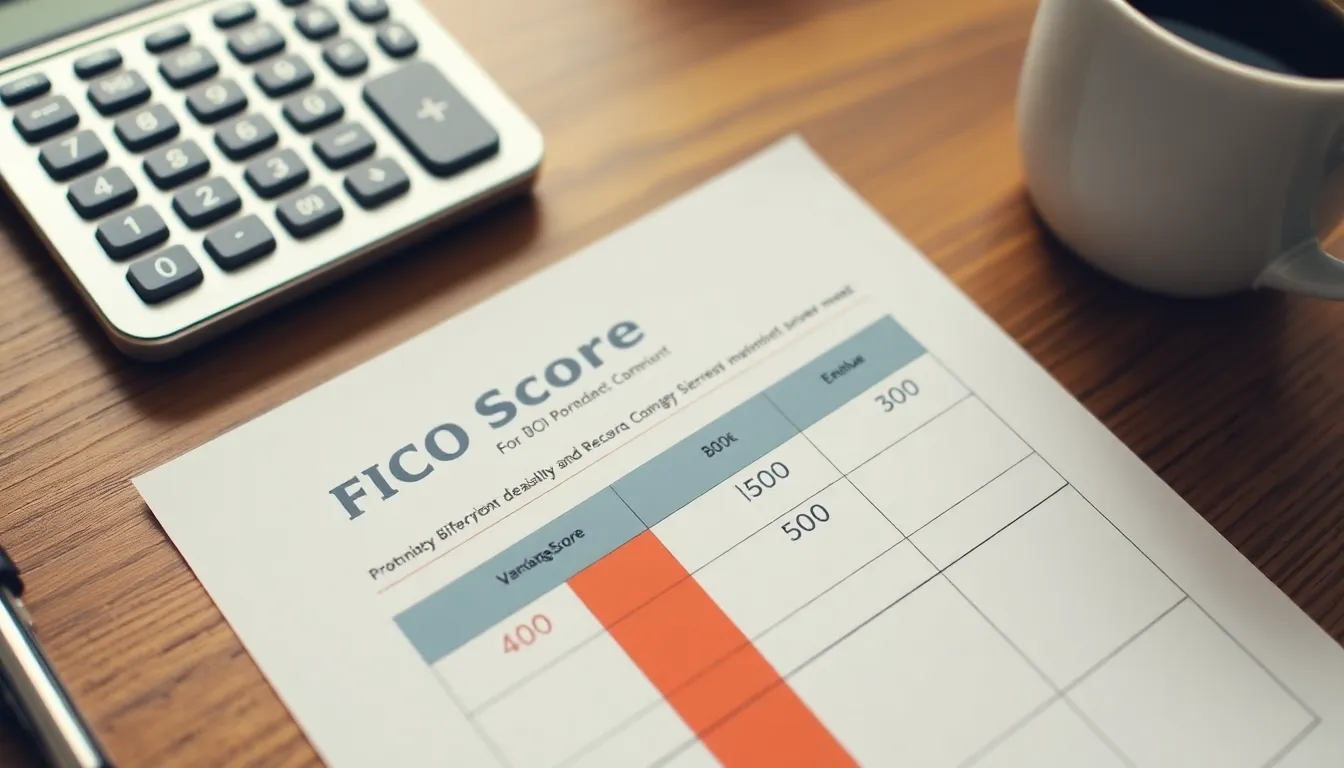Table of Contents
ToggleIn a world where buying a home or snagging that dream car often hinges on a three-digit number, understanding credit scores is more crucial than ever. It’s like being in a secret club where the bouncer checks your score before letting you in. Don’t worry though; it’s not as scary as it sounds.
What Is a Credit Score?
A credit score quantifies an individual’s creditworthiness. It plays a crucial role in financial decisions and influences loan approvals, interest rates, and more.
Definition and Importance
A credit score ranges from 300 to 850, with higher scores indicating lower risk. Lenders use credit scores to assess the likelihood of repayment. Your score affects not only loan access but also rental agreements and insurance premiums. Understanding credit scores empowers individuals to make informed financial choices. Aiming for a good credit score enhances borrowing power, making it essential for major purchases like homes and vehicles.
How Credit Scores Are Calculated
Credit scores rely on five key factors: payment history, credit utilization, length of credit history, new credit inquiries, and credit mix. Payment history contributes the most at 35%. Credit utilization follows at 30%, based on the ratio of credit used to credit available. Length of credit history accounts for 15%, with longer histories generally indicating reliability. New credit inquiries contribute 10% and should be limited. Lastly, credit mix, which includes various account types, comprises 10%. Understanding these factors clarifies how credit scores are formed.
Types of Credit Scores

Understanding the different types of credit scores is essential for making informed financial decisions. The two primary scoring models are FICO Score and VantageScore.
FICO Score
FICO Score remains the most widely used credit score model in the lending industry. Ranging from 300 to 850, this score helps lenders assess risk levels associated with potential borrowers. FICO Score components include payment history, credit utilization, length of credit history, types of credit, and new credit inquiries. Each factor has a different weight that influences the overall score. For instance, payment history holds a significant 35% weight. Many lenders prefer FICO scores due to their consistent accuracy and reliability.
VantageScore
VantageScore offers an alternative scoring model, developed by the three major credit bureaus: Experian, TransUnion, and Equifax. This score also ranges from 300 to 850, serving similar purposes in assessing credit risk. VantageScore employs a unique algorithm, focusing more on recent credit behaviors and trended data. For example, a consistent payment history contributes positively, while high credit utilization affects the score negatively. Since its introduction in 2006, VantageScore has gained popularity and is used by various lenders in decision-making processes.
Factors That Impact Your Credit Score
Several factors influence credit scores, each contributing differently to the overall assessment. Understanding these factors helps individuals manage and improve their credit.
Payment History
Payment history plays a critical role, accounting for 35% of the credit score. Making on-time payments demonstrates reliability and financial responsibility. Late payments, defaults, or bankruptcies negatively affect this score component. Regularly checking payment records aids in identifying potential issues.
Credit Utilization
Credit utilization measures the amount of credit used compared to the total available credit and represents 30% of the score. Keeping this ratio below 30% signals responsible credit management. High balances relative to credit limits can indicate financial distress, leading to lower scores. Monitoring spending habits ensures a favorable utilization ratio.
Length of Credit History
Length of credit history impacts 15% of the credit score, with longer histories favorably viewed. A longer credit history showcases a track record of responsible borrowing. Conversely, a shorter history can make it harder to assess reliability. Maintaining older accounts open helps enhance this aspect of the score.
Types of Credit Accounts
Types of credit accounts, which account for 10% of the score, reflect the diversity of credit used. A mix of revolving credit, such as credit cards, and installment loans, like mortgages, indicates financial versatility. Lenders prefer applicants with varied credit experiences. Striving for a balanced credit mix strengthens overall credit profiles.
Recent Credit Inquiries
Recent credit inquiries represent 10% of the overall credit score. Only hard inquiries impact this aspect, which occurs when applying for new credit. Multiple hard inquiries within a short time frame can lower scores, as they suggest potential financial instability. Limiting credit applications helps maintain a healthy score.
How to Improve Your Credit Score
Improving a credit score requires intentional actions and awareness of financial habits. Individuals can focus on specific areas that influence their scores.
Timely Payments
Timely payments enhance a credit score significantly because they constitute 35% of the total calculation. Making payments on or before the due date consistently reflects responsible financial behavior. Prioritizing bills such as credit cards, loans, and utilities ensures no missed payments affect the score. Setting up automatic payments or reminders can reduce the risk of late payments. Over time, a positive payment history builds trust with lenders and improves creditworthiness.
Reducing Debt
Reducing debt directly impacts credit scores since it relates to credit utilization, which accounts for 30% of the score. Individuals should aim to keep their credit utilization ratio below 30% to demonstrate fiscal responsibility. Paying off high-interest credit cards first can substantially lower outstanding balances. Regularly making more than the minimum payment also speeds up debt reduction. As debts decrease, the available credit increases, positively affecting the overall score.
Regular Credit Report Checks
Regular credit report checks enable individuals to maintain awareness of their financial standings. Accessing credit reports allows users to identify errors or discrepancies that could lower their scores. Reviewing reports from each of the three major credit bureaus ensures comprehensive monitoring of credit activity. Taking action on incorrect information can lead to significant score improvements. Additionally, staying informed about one’s credit status aids in understanding patterns and encourages proactive credit management.
Understanding credit scores is essential for anyone navigating the financial landscape. They serve as a key indicator of creditworthiness and can significantly impact financial opportunities. By grasping the factors that influence credit scores and taking actionable steps to improve them, individuals can enhance their financial health.
Focusing on timely payments and maintaining a low credit utilization ratio can lead to better scores and more favorable lending terms. Regularly monitoring credit reports ensures that individuals stay informed about their credit status. With this knowledge and proactive approach, achieving a strong credit score becomes an attainable goal, unlocking access to better financial options.







